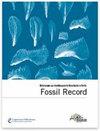下载PDF
{"title":"Globacrochordiceras gen. 11 . (acrochordicerdae,晚早三叠世)及其在氨类(头足类)进化跳跃中的意义","authors":"Claude Monnet, Hugo Bucher, Arnaud Brayard, James F. Jenks","doi":"10.1002/mmng.201300010","DOIUrl":null,"url":null,"abstract":"<p><i>Globacrochordiceras transpacificum</i> gen. et sp. nov. is an ammonoid (Ammonoidea, Cephalopoda) with a shell characterized by plicate ribbing (rounded and undulating ribs strengthening on the venter without interruption), increasing involution through ontogeny, overhanging and deep umbilical wall, absence of tuberculation, subtriangular whorl section, globose adult shape with a closed umbilicus followed by an abrupt egressive coiling, and a subammonitic adult suture line. This new taxon occurs in Nevada (USA) and in Guangxi (South China). It has its typical occurrence within the <i>Neopopanoceras haugi</i> Zone of late Spathian age (Early Triassic). The plicate ribbing, suture line and general shell shape are diagnostic of the family Acrochordiceratidae. The large adult size, high degree of involution and subammonitic suture line of <i>Globacrochordiceras</i> markedly contrast with the next younger genus of the family (<i>Paracrochordiceras</i> of early Anisian age, Middle Triassic), which is evolute and displays a ceratitic suture shape. Shell coiling and suture line of <i>Globacrochordiceras</i> are closer to that of the youngest member of the family: <i>Acrochordiceras carolinae</i> (late middle Anisian). The latter is the end-member of a long-term morphological evolutionary trend of the family during the early and middle Anisian. This trend composed of classical increases in adult size (Cope's rule), shell involution and suture indentation, lasted ca. four Myr. The sudden morphological evolutionary jump between <i>Globacrochordiceras</i> and <i>Paracrochordiceras</i> at the Spathian/Anisian (Early/Middle Triassic) boundary may correspond to a generalized morphological reset of long-term trends, a process that differs from classic paedomorphic transformations. A dramatic global sea level change and carbon isotope positive excursion at the Early/Middle Triassic boundary both indicate stressful environmental changes that may have triggered this evolutionary jump. (© 2013 WILEY-VCH Verlag GmbH & Co. KGaA, Weinheim)</p>","PeriodicalId":55147,"journal":{"name":"Fossil Record","volume":"16 2","pages":"197-215"},"PeriodicalIF":1.4000,"publicationDate":"2013-08-05","publicationTypes":"Journal Article","fieldsOfStudy":null,"isOpenAccess":false,"openAccessPdf":"https://sci-hub-pdf.com/10.1002/mmng.201300010","citationCount":"21","resultStr":"{\"title\":\"Globacrochordiceras gen. nov. (Acrochordiceratidae, late Early Triassic) and its significance for stress-induced evolutionary jumps in ammonoid lineages (cephalopods)\",\"authors\":\"Claude Monnet, Hugo Bucher, Arnaud Brayard, James F. Jenks\",\"doi\":\"10.1002/mmng.201300010\",\"DOIUrl\":null,\"url\":null,\"abstract\":\"<p><i>Globacrochordiceras transpacificum</i> gen. et sp. nov. is an ammonoid (Ammonoidea, Cephalopoda) with a shell characterized by plicate ribbing (rounded and undulating ribs strengthening on the venter without interruption), increasing involution through ontogeny, overhanging and deep umbilical wall, absence of tuberculation, subtriangular whorl section, globose adult shape with a closed umbilicus followed by an abrupt egressive coiling, and a subammonitic adult suture line. This new taxon occurs in Nevada (USA) and in Guangxi (South China). It has its typical occurrence within the <i>Neopopanoceras haugi</i> Zone of late Spathian age (Early Triassic). The plicate ribbing, suture line and general shell shape are diagnostic of the family Acrochordiceratidae. The large adult size, high degree of involution and subammonitic suture line of <i>Globacrochordiceras</i> markedly contrast with the next younger genus of the family (<i>Paracrochordiceras</i> of early Anisian age, Middle Triassic), which is evolute and displays a ceratitic suture shape. Shell coiling and suture line of <i>Globacrochordiceras</i> are closer to that of the youngest member of the family: <i>Acrochordiceras carolinae</i> (late middle Anisian). The latter is the end-member of a long-term morphological evolutionary trend of the family during the early and middle Anisian. This trend composed of classical increases in adult size (Cope's rule), shell involution and suture indentation, lasted ca. four Myr. The sudden morphological evolutionary jump between <i>Globacrochordiceras</i> and <i>Paracrochordiceras</i> at the Spathian/Anisian (Early/Middle Triassic) boundary may correspond to a generalized morphological reset of long-term trends, a process that differs from classic paedomorphic transformations. A dramatic global sea level change and carbon isotope positive excursion at the Early/Middle Triassic boundary both indicate stressful environmental changes that may have triggered this evolutionary jump. (© 2013 WILEY-VCH Verlag GmbH & Co. KGaA, Weinheim)</p>\",\"PeriodicalId\":55147,\"journal\":{\"name\":\"Fossil Record\",\"volume\":\"16 2\",\"pages\":\"197-215\"},\"PeriodicalIF\":1.4000,\"publicationDate\":\"2013-08-05\",\"publicationTypes\":\"Journal Article\",\"fieldsOfStudy\":null,\"isOpenAccess\":false,\"openAccessPdf\":\"https://sci-hub-pdf.com/10.1002/mmng.201300010\",\"citationCount\":\"21\",\"resultStr\":null,\"platform\":\"Semanticscholar\",\"paperid\":null,\"PeriodicalName\":\"Fossil Record\",\"FirstCategoryId\":\"89\",\"ListUrlMain\":\"https://onlinelibrary.wiley.com/doi/10.1002/mmng.201300010\",\"RegionNum\":4,\"RegionCategory\":\"地球科学\",\"ArticlePicture\":[],\"TitleCN\":null,\"AbstractTextCN\":null,\"PMCID\":null,\"EPubDate\":\"\",\"PubModel\":\"\",\"JCR\":\"Q3\",\"JCRName\":\"Earth and Planetary Sciences\",\"Score\":null,\"Total\":0}","platform":"Semanticscholar","paperid":null,"PeriodicalName":"Fossil Record","FirstCategoryId":"89","ListUrlMain":"https://onlinelibrary.wiley.com/doi/10.1002/mmng.201300010","RegionNum":4,"RegionCategory":"地球科学","ArticlePicture":[],"TitleCN":null,"AbstractTextCN":null,"PMCID":null,"EPubDate":"","PubModel":"","JCR":"Q3","JCRName":"Earth and Planetary Sciences","Score":null,"Total":0}
引用次数: 21
引用
批量引用


